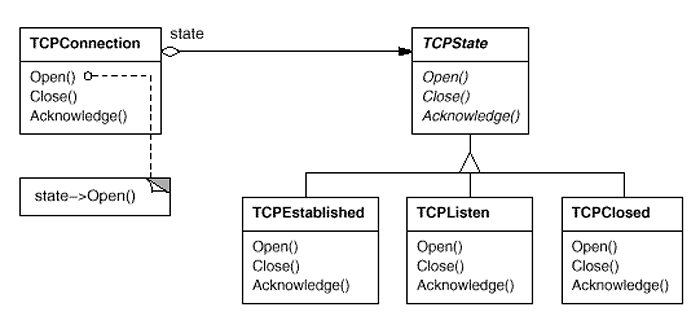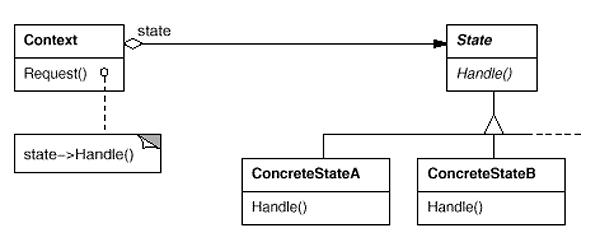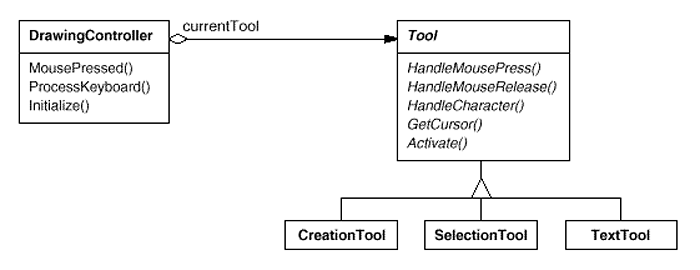State
Intent
Allow an object to alter its behavior when its internal state changes. The object will appear to change its class.
Also Known As
Objects for States
Motivation
Consider a class TCPConnection that represents a network connection. A TCPConnection object can be in one of several different states: Established, Listening, Closed. When a TCPConnection object receives requests from other objects, it responds differently depending on its current state. For example, the effect of an Open request depends on whether the connection is in its Closed state or its Established state. The State pattern describes how TCPConnection can exhibit different behavior in each state.
The key idea in this pattern is to introduce an abstract class called TCPState to represent the states of the network connection. The TCPState class declares an interface common to all classes that represent different operational states. Subclasses of TCPState implement state-specific behavior. For example, the classes TCPEstablished and TCPClosed implement behavior particular to the Established and Closed states of TCPConnection.

The class TCPConnection maintains a state object (an instance of a subclass of TCPState) that represents the current state of the TCP connection. The class TCPConnection delegates all state-specific requests to this state object. TCPConnection uses its TCPState subclass instance to perform operations particular to the state of the connection.
Whenever the connection changes state, the TCPConnection object changes the state object it uses. When the connection goes from established to closed, for example, TCPConnection will replace its TCPEstablished instance with a TCPClosed instance.
Applicability
Use the State pattern in either of the following cases:
- An object's behavior depends on its state, and it must change its behavior at run-time depending on that state.
- Operations have large, multipart conditional statements that depend on the object's state. This state is usually represented by one or more enumerated constants. Often, several operations will contain this same conditional structure. The State pattern puts each branch of the conditional in a separate class. This lets you treat the object's state as an object in its own right that can vary independently from other objects.
Structure

Participants
- Context (TCPConnection)
- defines the interface of interest to clients.
- maintains an instance of a ConcreteState subclass that defines the current state.
- State (TCPState)
- defines an interface for encapsulating the behavior associated with a particular state of the Context.
- ConcreteState subclasses (TCPEstablished, TCPListen, TCPClosed)
- each subclass implements a behavior associated with a state of the Context.
Collaborations
- Context delegates state-specific requests to the current ConcreteState object.
- A context may pass itself as an argument to the State object handling the request. This lets the State object access the context if necessary.
- Context is the primary interface for clients. Clients can configure a context with State objects. Once a context is configured, its clients don't have to deal with the State objects directly.
- Either Context or the ConcreteState subclasses can decide which state succeeds another and under what circumstances.
Consequences
The State pattern has the following consequences:
- It localizes state-specific behavior and partitions behavior for different states. The State pattern puts all behavior associated with a particular state into one object. Because all state-specific code lives in a State subclass, new states and transitions can be added easily by defining new subclasses.
An alternative is to use data values to define internal states and have Context operations check the data explicitly. But then we'd have look-alike conditional or case statements scattered throughout Context's implementation. Adding a new state could require changing several operations, which complicates maintenance.
The State pattern avoids this problem but might introduce another, because the pattern distributes behavior for different states across several State subclasses. This increases the number of classes and is less compact than a single class. But such distribution is actually good if there are many states, which would otherwise necessitate large conditional statements.
Like long procedures, large conditional statements are undesirable. They're monolithic and tend to make the code less explicit, which in turn makes them difficult to modify and extend. The State pattern offers a better way to structure state-specific code. The logic that determines the state transitions doesn't reside in monolithic if or switch statements but instead is partitioned between the State subclasses. Encapsulating each state transition and action in a class elevates the idea of an execution state to full object status. That imposes structure on the code and makes its intent clearer.
- It makes state transitions explicit. When an object defines its current state solely in terms of internal data values, its state transitions have no explicit representation; they only show up as assignments to some variables. Introducing separate objects for different states makes the transitions more explicit. Also, State objects can protect the Context from inconsistent internal states, because state transitions are atomic from the Context's perspective—they happen by rebinding one variable (the Context's State object variable), not several [dCLF93].
- State objects can be shared. If State objects have no instance variables—that is, the state they represent is encoded entirely in their type—then contexts can share a State object. When states are shared in this way, they are essentially flyweights (see Flyweight (195)) with no intrinsic state, only behavior.
Implementation
The State pattern raises a variety of implementation issues:
- Who defines the state transitions? The State pattern does not specify which participant defines the criteria for state transitions. If the criteria are fixed, then they can be implemented entirely in the Context. It is generally more flexible and appropriate, however, to let the State subclasses themselves specify their successor state and when to make the transition. This requires adding an interface to the Context that lets State objects set the Context's current state explicitly.
Decentralizing the transition logic in this way makes it easy to modify or extend the logic by defining new State subclasses. A disadvantage of decentralization is that one State subclass will have knowledge of at least one other, which introduces implementation dependencies between subclasses.
- A table-based alternative. In C++ Programming Style [Car92], Cargill describes another way to impose structure on state-driven code: He uses tables to map inputs to state transitions. For each state, a table maps every possible input to a succeeding state. In effect, this approach converts conditional code (and virtual functions, in the case of the State pattern) into a table look-up.
The main advantage of tables is their regularity: You can change the transition criteria by modifying data instead of changing program code. There are some disadvantages, however:
- A table look-up is often less efficient than a (virtual) function call.
- Putting transition logic into a uniform, tabular format makes the transition criteria less explicit and therefore harder to understand.
- It's usually difficult to add actions to accompany the state transitions. The table-driven approach captures the states and their transitions, but it must be augmented to perform arbitrary computation on each transition.
The key difference between table-driven state machines and the State pattern can be summed up like this: The State pattern models state-specific behavior, whereas the table-driven approach focuses on defining state transitions.
- Creating and destroying State objects. A common implementation trade-off worth considering is whether (1) to create State objects only when they are needed and destroy them thereafter versus (2) creating them ahead of time and never destroying them.
The first choice is preferable when the states that will be entered aren't known at run-time, and contexts change state infrequently. This approach avoids creating objects that won't be used, which is important if the State objects store a lot of information. The second approach is better when state changes occur rapidly, in which case you want to avoid destroying states, because they may be needed again shortly. Instantiation costs are paid once up-front, and there are no destruction costs at all. This approach might be inconvenient, though, because the Context must keep references to all states that might be entered.
- Using dynamic inheritance. Changing the behavior for a particular request could be accomplished by changing the object's class at run-time, but this is not possible in most object-oriented programming languages. Exceptions include Self [US87] and other delegation-based languages that provide such a mechanism and hence support the State pattern directly. Objects in Self can delegate operations to other objects to achieve a form of dynamic inheritance. Changing the delegation target at run-time effectively changes the inheritance structure. This mechanism lets objects change their behavior and amounts to changing their class.
Sample Code
The following example gives the C++ code for the TCP connection example described in the Motivation section. This example is a simplified version of the TCP protocol; it doesn't describe the complete protocol or all the states of TCP connections.8
First, we define the class TCPConnection, which provides an interface for transmitting data and handles requests to change state.
class TCPOctetStream; class TCPState; class TCPConnection { public: TCPConnection(); void ActiveOpen(); void PassiveOpen(); void Close(); void Send(); void Acknowledge(); void Synchronize(); void ProcessOctet(TCPOctetStream*); private: friend class TCPState; void ChangeState(TCPState*); private: TCPState* _state; }; TCPConnection keeps an instance of the TCPState class in the _state member variable. The class TCPState duplicates the state-changing interface of TCPConnection. Each TCPState operation takes a TCPConnection instance as a parameter, letting TCPState access data from TCPConnection and change the connection's state.
class TCPState { public: virtual void Transmit(TCPConnection*, TCPOctetStream*); virtual void ActiveOpen(TCPConnection*); virtual void PassiveOpen(TCPConnection*); virtual void Close(TCPConnection*); virtual void Synchronize(TCPConnection*); virtual void Acknowledge(TCPConnection*); virtual void Send(TCPConnection*); protected: void ChangeState(TCPConnection*, TCPState*); }; TCPConnection delegates all state-specific requests to its TCPState instance _state. TCPConnection also provides an operation for changing this variable to a new TCPState. The constructor for TCPConnection initializes the object to the TCPClosed state (defined later).
TCPConnection::TCPConnection () { _state = TCPClosed::Instance(); } void TCPConnection::ChangeState (TCPState* s) { _state = s; } void TCPConnection::ActiveOpen () { _state->ActiveOpen(this); } void TCPConnection::PassiveOpen () { _state->PassiveOpen(this); } void TCPConnection::Close () { _state->Close(this); } void TCPConnection::Acknowledge () { _state->Acknowledge(this); } void TCPConnection::Synchronize () { _state->Synchronize(this); } TCPState implements default behavior for all requests delegated to it. It can also change the state of a TCPConnection with the ChangeState operation. TCPState is declared a friend of TCPConnection to give it privileged access to this operation.
void TCPState::Transmit (TCPConnection*, TCPOctetStream*) { } void TCPState::ActiveOpen (TCPConnection*) { } void TCPState::PassiveOpen (TCPConnection*) { } void TCPState::Close (TCPConnection*) { } void TCPState::Synchronize (TCPConnection*) { } void TCPState::ChangeState (TCPConnection* t, TCPState* s) { t->ChangeState(s); } Subclasses of TCPState implement state-specific behavior. A TCP connection can be in many states: Established, Listening, Closed, etc., and there's a subclass of TCPState for each state. We'll discuss three subclasses in detail: TCPEstablished, TCPListen, and TCPClosed.
class TCPEstablished : public TCPState { public: static TCPState* Instance(); virtual void Transmit(TCPConnection*, TCPOctetStream*); virtual void Close(TCPConnection*); }; class TCPListen : public TCPState { public: static TCPState* Instance(); virtual void Send(TCPConnection*); // ... }; class TCPClosed : public TCPState { public: static TCPState* Instance(); virtual void ActiveOpen(TCPConnection*); virtual void PassiveOpen(TCPConnection*); // ... }; TCPState subclasses maintain no local state, so they can be shared, and only one instance of each is required. The unique instance of each TCPState subclass is obtained by the static Instance operation.9
Each TCPState subclass implements state-specific behavior for valid requests in the state:
void TCPClosed::ActiveOpen (TCPConnection* t) { // send SYN, receive SYN, ACK, etc. ChangeState(t, TCPEstablished::Instance()); } void TCPClosed::PassiveOpen (TCPConnection* t) { ChangeState(t, TCPListen::Instance()); } void TCPEstablished::Close (TCPConnection* t) { // send FIN, receive ACK of FIN ChangeState(t, TCPListen::Instance()); } void TCPEstablished::Transmit ( TCPConnection* t, TCPOctetStream* o ) { t->ProcessOctet(o); } void TCPListen::Send (TCPConnection* t) { // send SYN, receive SYN, ACK, etc. ChangeState(t, TCPEstablished::Instance()); } After performing state-specific work, these operations call the ChangeState operation to change the state of the TCPConnection. TCPConnection itself doesn't know a thing about the TCP connection protocol; it's the TCPState subclasses that define each state transition and action in TCP.
Known Uses
Johnson and Zweig [JZ91] characterize the State pattern and its application to TCP connection protocols.
Most popular interactive drawing programs provide "tools" for performing operations by direct manipulation. For example, a line-drawing tool lets a user click and drag to create a new line. A selection tool lets the user select shapes. There's usually a palette of such tools to choose from. The user thinks of this activity as picking up a tool and wielding it, but in reality the editor's behavior changes with the current tool: When a drawing tool is active we create shapes; when the selection tool is active we select shapes; and so forth. We can use the State pattern to change the editor's behavior depending on the current tool.
We can define an abstract Tool class from which to define subclasses that implement tool-specific behavior. The drawing editor maintains a current Tool object and delegates requests to it. It replaces this object when the user chooses a new tool, causing the behavior of the drawing editor to change accordingly..
This technique is used in both the HotDraw [Joh92] and Unidraw [VL90] drawing editor frameworks. It allows clients to define new kinds of tools easily. In HotDraw, the DrawingController class forwards the requests to the current Tool object. In Unidraw, the corresponding classes are Viewer and Tool. The following class diagram sketches the Tool and DrawingController interfaces:

Coplien's Envelope-Letter idiom [Cop92] is related to State. Envelope-Letter is a technique for changing an object's class at run-time. The State pattern is more specific, focusing on how to deal with an object whose behavior depends on its state.
Related Patterns
The Flyweight pattern explains when and how State objects can be shared.
State objects are often Singletons.
8This example is based on the TCP connection protocol described by Lynch and Rose [LR93]. 9This makes each TCPState subclass a Singleton (see Singleton ).
EAN: 2147483647
Pages: 40